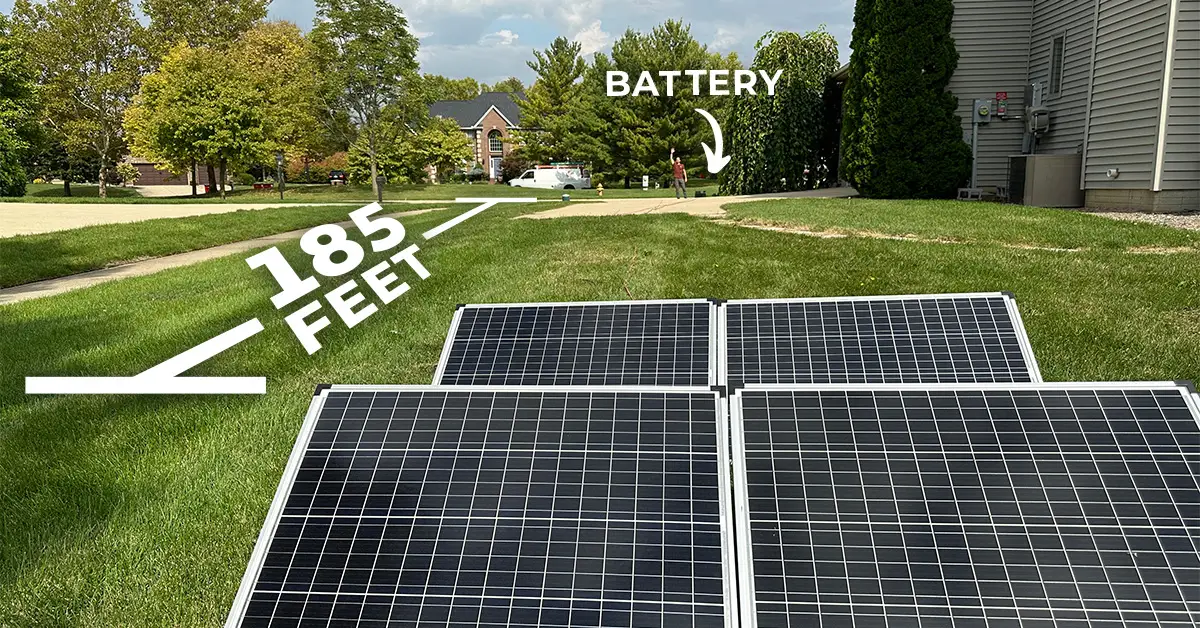Are you planning a DIY solar setup where your solar panels are quite a distance away from the rest of your equipment? Then line loss is something you absolutely need to consider.
In this guide, I’ll walk you through how to use an online calculator that will give an estimate of line losses, and compare it to real-world test results.
Then, we’ll change a few variables in our test to see how it reduces our losses.
Rather watch than read? Check out this 11-minute video.
Understanding Line Loss in Solar Power Systems
Understanding line loss is crucial when setting up your solar power system. When electricity flows through a wire, some of it gets lost along the way, impacting the efficiency of your solar system.
This loss is influenced by the length and thickness of the wire, as well as the amount of current flowing through it.
So, let’s take a look at the maximum continuous current of wires.
Wire Gauge and Current Capacity:
- 10 gauge wire: Maximum continuous current of 30 amps
- 12 gauge wire: Maximum continuous current of 20 amps
- 14 gauge wire: Maximum continuous current of 15 amps
Remember, these are all maximums. When running long stretches of wire, you can have considerable losses between your solar panels and where the power is landing (in our case, a portable power station 185 feet away).
Curious about how wire gauge impacts line losses? Check out our article on testing 8 gauge, 10 gauge, and 12 gauge wires over 100 feet sections.
Online Calculators for Line Loss
Online calculators can estimate the losses based on your setup, but nothing beats real-world results. Next up, we’ll get our estimation, and then we’ll compare it to our actual test results.
Power Loss Estimator: Crunching the Numbers
To get our estimated power loss, we’ll use this power loss estimator.

Here are the parameters of our test that I’ve entered into the calculator:
- Material: Copper wire
- Size: 10 AWG
- Phase and Number of Wires: 1-phase, 2-wire
- Voltage: 36 (My system comprises Thunderbolts at 18 volts, arranged with two in parallel and two in series, resulting in a total of 36 volts.)
- 1-Way Circuit Length: 185 Feet
- Amperage: Max 11.2, adjusted to 7 amps for a partly cloudy day
Line Loss Estimation: Based on these parameters, the calculator estimates a line loss of 8.9%.
Line Loss Test Setup
Now let’s dive into the test setup to provide a clear picture of what we’re working with:
- Solar Panels: Four 100-watt Thunderbolt panels from Harbor Freight, producing 18 volts at 5.6 amps each.
- Panel Configuration: Front two panels wired in parallel, back two panels wired in parallel, and then bringing those together in series.
- Power Analyzers: Used to measure voltage, amperage, and overall watt hours accumulated during the test.
- Cabling: 185 feet of 10-gauge solar wire, designed for direct burial and resistant to solar degradation.
- Portable Power Station: EcoFlow Delta Pro, acting as the hub for storing the solar-generated power.

Power Analyzer Limitations
Before we continue with the test, I want to note the constraints of our power analyzer.
While it’s a valuable tool, it has a maximum voltage limit of 100 volts. This limitation can dictate the configuration of our setup, so we may choose parallel wiring over series wiring for our tests.
Also worth noting, I use watt-hours as a metric because it allows us to gauge energy accumulation over time. This provides a more comprehensive comparison between what the panels produce and what is stored. It’s also useful on partly cloudy days when a spot check might be misleading.
Test Results vs. Estimation
After running the test for about three hours on a partly cloudy day, we have our results:
- Accumulated Watt Hours at Panels: 587 Wh
- Observed Watt Hours at EcoFlow: 537 Wh
- Line Loss: 8.5%

Surprisingly, the real-world results were close to the estimation of 8.9%, demonstrating the reliability of the power loss estimator.
Adjusting to Reduce Line Loss: Series Configuration
To reduce our line losses, I decided to experiment with a series configuration for the solar panels.
A 30-minute trial in a series configuration showcased a remarkable 1.6% line loss.

This reinforces the benefits of wiring panels in series, lowering amperage and improving overall efficiency.
Here’s a quick rundown of the advantages and results of wiring in-series:
Advantages
- Higher voltage, lower amperage
- Reduced line losses
- Cost-effective wiring
Results of Series Configuration
- Line loss estimation: 2.2%
- Actual line loss: 1.6%
It goes to show, if you can wire in series, wire in series. This will bring down your line losses and also keep your cost of wiring lower.
Conclusion and Final Thoughts
To wrap things up, here is a quick recap of what we’ve learned:
- Line loss is a significant consideration when your solar panels are at a distance from essential equipment.
- The choice of wire gauge and the current capacity of the wire play a crucial role.
- Online calculators do a pretty good job of estimating line losses.
- Our real-world DIY solar test showed that tweaking the wiring into a series configuration slashed line losses to just 1.6%.
- Wiring in series proves to be a practical move, especially for longer cable distances, offering a straightforward way to amp up your solar system’s efficiency.
Solar for Your Home
On a side note, if you’re considering solar for your home, now is a great time with various federal, state, and municipal incentives available.
Check out this link for an estimate of the size and cost of a solar system for your home.
Stay Connected: Your Feedback Matters
Your feedback is important! Share your thoughts, suggestions, and any data collection equipment recommendations in the comments. Let’s build a community of solar enthusiasts supporting each other in DIY projects.

